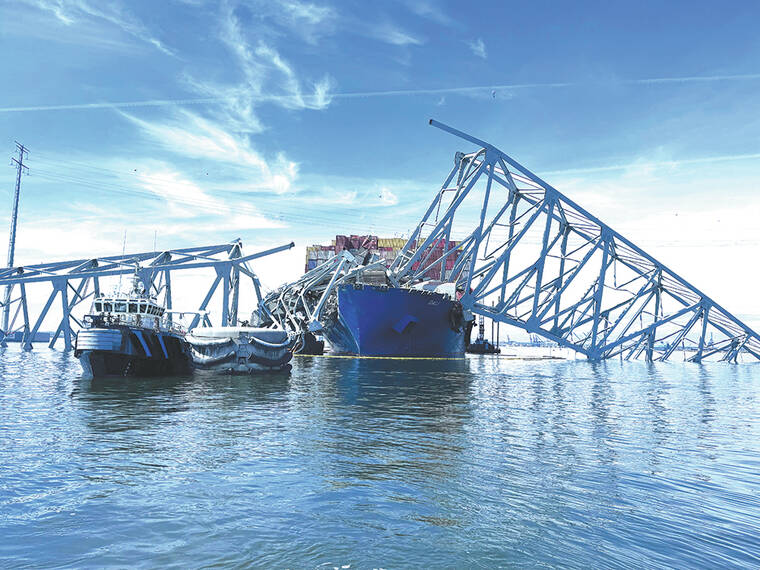A channel has opened for vessels clearing wreckage at the Baltimore bridge collapse site
BALTIMORE — The U.S. Coast Guard has opened a temporary, alternate channel for vessels involved in clearing debris from the collapsed Francis Scott Key Bridge in Baltimore, part of a phased approach to opening the main shipping channel leading to the vital port, officials said Monday.
Crews are undertaking the complicated work of removing steel and concrete at the site of the bridge’s deadly collapse after a container ship lost power and crashed into a supporting column. On Sunday, dive teams surveyed parts of the bridge and checked the ship, and workers in lifts used torches to cut above-water parts of the twisted steel superstructure.
Officials said the temporary channel is open primarily to vessels that are helping with the cleanup effort. Some barges and tugs that have been stuck in the Port of Baltimore since the collapse are also scheduled to pass through the channel.
Authorities believe six workers plunged to their deaths in the collapse, including two whose bodies were recovered last week.
Maryland Gov. Wes Moore said at a Monday afternoon news conference that his top priority is recovering the four remaining bodies, followed by reopening shipping channels to the port. He said he understands the urgency but that the risks are significant. He said crews have described the mangled steel girders of the fallen bridge as “chaotic wreckage.”
“What we’re finding is it is more complicated than we hoped for initially,” said U.S. Coast Guard Rear Admiral Shannon Gilreath.
Moore said crews used a large crane to lift a 200-ton (180-metric ton) span of the bridge, a task that took 10 hours. He said the piece was considered a “relatively small lift” in the grand scheme of the recovery effort, which he called enormous.
Moore said crews would lift another 350-ton (317-metric ton) piece from the bridge later Monday as weather allows.
Officials earlier said the temporary channel would have a controlling depth of 11 feet (over 3 meters), a horizontal clearance of 264 feet (80 meters) and a vertical clearance of 96 feet (29 meters).
“This marks an important first step along the road to reopening the port of Baltimore,” Capt. David O’Connell, the federal on-scene coordinator of the response, said in a statement Monday. “By opening this alternate route, we will support the flow of marine traffic into Baltimore.”
Two additional larger channels are planned as more debris is removed from the waterway. Officials declined to provide a projected timeline for those channels being opened.
Meanwhile, the ship remains stationary, and its 21 crew members remain on board for the foreseeable future, officials said. Twenty of them are from India, and one is from Sri Lanka, said Will Marks, a spokesperson for the crew. He said they’re currently busy maintaining the ship and cooperating with investigators from the National Transportation Safety Board and the U.S. Coast Guard.


